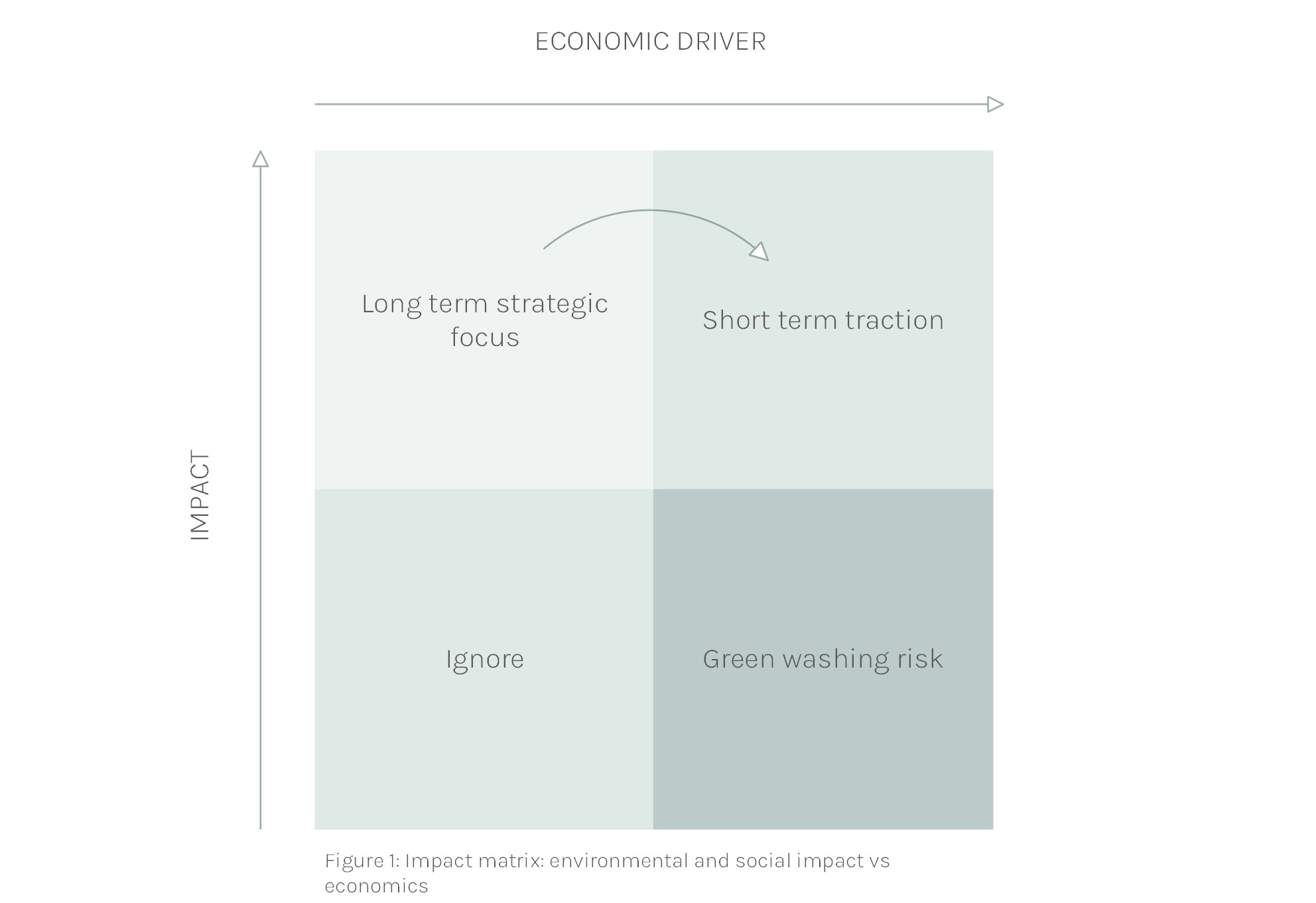- Why the Term "Social Business" Should Not Exist
- Unlocking the Potential of African Agribusiness in Sustainable Value Chains
- Steps to Develop and Implement a Profitable Impact Strategy
- Key Elements of an Impact Strategy for African Agribusiness
- Conclusion
Sustainability has become a crucial focus for businesses worldwide, and African agribusinesses are well positioned to lead the way in creating sustainable value chains. An effective impact strategy not only helps in mitigating negative social and environmental impacts but also opens up new options for competitive advantage and long-term profitability. This article delves into the core elements of an impact strategy, particularly in the context of African agribusiness and agri-processing, offering detailed insights and practical guidance. But first some context.
Why the Term "Social Business" Should Not Exist
Our economic system evolved during a time when the planet had little difficulty to absorb the negative externalities of human activity. However, we are now on a trajectory that requires the resources of two planets to sustain the human population. If everyone lived like the average American citizen we would need nearly five planets, which is clearly not feasible. We need to rapidly change our practices and return to a situation where our economies function within planetary boundaries.
The fundamental problem is that we consider it “normal” for businesses to generate negative social and environmental impacts: It’s just the way things are. However, in our daily lives we accept that if you create a mess, you take responsibility for cleaning it up. Somehow, this norm is not extended to businesses. We have even developed language to designate businesses that limit or strive to eliminate their negative impacts, calling them “social businesses”.
It gets worse: companies that produce, manufacture and trade more sustainably are often required to bear additional costs to prove their sustainability, such as certification fees, value chain audits and traceability systems. This is the world upside down. We should instead distinguish between business and anti-social business, imposing additional costs on the latter.
As the Birtish Academy puts it in their paper Principles for Purposeful Business, “the purpose of business is to solve the problems of people and planet profitably, and not profit from causing problems”. This statement articulates our current attitude problem and the change required pretty well.
Change is underway. Just like awareness of the negative impact of smoking led to increasingly strict legislation, the same is happening to control the negative impacts of business. The EU is leading the way with such legislation as the EU deforestation regulation (EUDR), the Corporate Sustainability Reporting Directive (CSRD) and the Corporate Sustainability Due Diligence Directive (CSDDD). Just as we would no longer accept adults smoking in a car with children, one day we will look back on our current business practices and wonder how we could be so blind to their negative impacts. Future generations will most likely consider our economic system to be on the wrong side of history.
I’m not here to judge. I don’t care if you want to embark on an impact strategy out of intrinsic motivation to do the right thing, because you spot a business opportunity, or because you’re afraid of being left behind due to legislative changes. I do know that the transition that we, and the planet need will be realized a lot faster if there’s money to be made while doing it. That’s just part of human nature. I recognize that there is a whole spectrum of “impact awareness” and someone who might start out on an impact journey because of legislative pressure might one day lead the change for an entire industry. Wherever you are on that spectrum, this article will set out how to craft an effective impact strategy and make money while doing it.

Unlocking the Potential of African Agribusiness in Sustainable Value Chains
African agribusinesses have a unique opportunity to be at the forefront of sustainable value chains for several key reasons. Firstly, Africa boasts vast arable land, diverse climates, and rich biodiversity, which provide a strong foundation for sustainable agricultural practices. These abundant natural resources allow for the cultivation of a wide range of crops, including those suited for organic and environmentally friendly farming methods.
Secondly, there is an increasing demand for sustainably produced food both within Africa and globally. Consumers are becoming more conscious of the environmental and social impacts of their buying behaviour, leading to a growing market for products that are certified organic, fair trade, and sustainably sourced.
Additionally, the geographical proximity of Africa to the European Union (EU) is a significant advantage. The EU is leading in sustainability legislation and has a strong demand for sustainably produced goods. Lower transportation costs and quicker access allows African agri-processors to respond swiftly to market needs and to take advantage of the EU’s emphasis on sustainability.
The availability of a large, young, and relatively low-cost labour force in African cities further strengthens the continent’s position. This abundant labour force can enhance productivity and facilitate value addition. Moreover, since the COVID-19 pandemic, businesses have become more focused on the resilience of their supply chains. This renewed focus has sparked interest in sourcing from Africa, as companies seek to diversify their supply bases and reduce dependency on single sources, making African agribusinesses more attractive partners.
Lastly, investors and development finance institutions are increasingly focusing on funding projects with strong sustainability credentials. African agri-processors that commit to sustainable practices can attract investment and access higher-value markets. By demonstrating their sustainability efforts, these businesses can secure the financial support needed to scale operations, adopt new technologies, and expand their market reach.
In conclusion, African agribusinesses are uniquely positioned to benefit from the development of sustainable value chains due to their rich natural resources, growing market demand, strategic proximity to the EU, abundant labour force, enhanced focus on supply chain resilience, and access to investment. These factors collectively create the conditions for African agri-processors to lead in sustainable agribusiness and achieve long-term success.
Steps to Develop and Implement a Profitable Impact Strategy
Developing and executing an effective and profitable impact strategy involves several steps: measuring externalities, identifying drivers of competitive advantage, evaluating options to bring focus to the strategy and finally aligning the organization and facilitating cultural shift. Let’s explore these one by one.
How to Measure and Monetize Externalities in Agribusiness with the True Price Standard
Putting solar panels on your factory roof is a step in the right direction, but it is not a comprehensive impact strategy. A credible strategy starts by measuring the negative environmental and social impacts of the business and the supply chain, making them comparable.
The framework we find most comprehensive is the True Price standard. The True Price standard helps by putting a price on your negative impacts. If your current product price is X and your negative social and environmental impact, converted into money is Y, then the True Price of your product is X + Y. For a detailed example of this methodology, we recommend reading the True Price of Cocoa report by True Price and IDH. Further resources on the True Price standard and monetization factors can be found here.
What needs to be measured? Apart from greenhouse gas emissions there are issues such as degradation of land, biodiversity and ecosystems, the use of scarce (finite) resources, the lack of a decent living standard or occupational health and safety issues in your value chain. These are just a sample of the different externalities included in the True Price standard.
Initially, the standard and all its different elements can be a bit overwhelming. The main thing is getting started. Keep it simple, select a few factors that are most relevant to the business and take it from there. For food and agribusiness, I’d suggest including at the minimum greenhouse gas emissions, one or two proxies for biodiversity such as land use and toxicity to ecosystems and the lack of a decent living standard for value chain actors.
Why is it important to measure your externalities and convert them into monetary values? First, measuring and communicating transparently about your externalities sets you apart from businesses that do not. Many businesses face accusations of greenwashing because they highlight a few positive impact projects while ignoring their negative externalities. Using a standard like True Price brings independent measurement, comprehensiveness, and transparency to your impact strategy, differentiating you from competitors who make bold but unsubstantial claims.
Second, converting your externalities into monetary units enables businesses to harness their core strength: cost-effectiveness. By monetizing externalities, you can make better investment decisions, evaluate performance more effectively, and communicate more clearly with clients, employees, shareholders, and investors. Monetization of externalities allows for the integration of continuous improvement processes and conventional business metrics into your impact strategy, driving both profitability and positive change.
Competitive Advantage in Sustainable Agribusiness: Key Drivers and Strategies
The purpose of using a standard like True Price is not to raise your prices to offset negative externalities. Concerns about plummeting market shares due to higher prices are valid, but that is not the goal. The key issue is to work on preventing negative externalities profitably.
Until regulation catches up, there is no level playing field for companies focusing on minimizing negative externalities. Simply internalizing these costs can put you at a disadvantage. The trick is to craft a strategy that derives competitive advantage from reducing negative externalities before regulations shift.
Despite the additional costs associated with sustainable business practices, there are several drivers of profit you can leverage for your impact strategy. Multiple studies have identified elements contributing to competitive advantage through impact. For a comprehensive read, we recommend the BCG guide on the transition to net zero. We have successfully used the following five levers to develop sustainable value chains in Africa:
- Premium Prices and Market Share: Market niches exist where customers are willing to pay premium prices for sustainable products. Certain clients will only buy from suppliers with verified sustainability practices, and sustainable markets are growing faster than traditional ones.
- Attracting and Retaining Talent: Sustainable businesses attract better talent, which drives productivity improvements and reduces turnover costs.
- Lower Risk Profile: Clients prefer longer-term contracts with sustainable sources over opportunistic buying. This reduces exposure to market volatility and regulatory changes, making your business more resilient.
- Lower Cost of Finance: Sustainable businesses often benefit from better financing terms, both for equity and debt, due to lower perceived risks.
- Cost Efficiency: Innovative use of waste streams through upcycling and recycling, along with improvements in energy and resource efficiency, can significantly lower operational costs.
Depending on your activities and the countries you operate in, some elements may be more appropriate for your strategy than others. We have achieved great results by generating price premiums for our products, gaining market share, and improving our risk profile through reduced exposure to market volatility. We have also consistently attracted interest from impact investors eager to finance our business.
Using the 2x2 Framework to Bring Focus to Impact Strategies
Focusing on high-impact and high-profitability opportunities while avoiding greenwashing is essential. Once you have a clear view of your negative externalities, you need to focus your transition efforts. Applying the 80/20 rule will help you quickly identify where most impact can be realized—approximately 80% of your negative impact will be caused by 20% of factors. These are the ones you will want to focus on.

Simultaneously, ensure that you derive competitive advantage from your actions. To gain clarity, we’ve developed a simple 2×2 matrix that helps businesses balance economic drivers with social and environmental impacts. It categorizes business actions into four quadrants:
- Long-Term Strategic Focus: This quadrant involves high-impact activities with low immediate economic returns. These efforts build credibility and strategic advantage by demonstrating a commitment to sustainability, even at the expense of short-term profits. Ideally, projects in this quadrant have the potential to transition towards high economic impact in the future. Examples include developing innovative products from waste streams. Most innovation takes place in this quadrant, and first-mover advantage could be a possible driver of future profitability. If there is little potential for financial upside, you should ideally have additional upside in short-term traction quadrant projects or make a conscious decision to live a happy life knowing that you’ve substantially decreased your negative externalities and were willing to pay for it.
- Short-Term Traction: Activities in this quadrant offer both high impact and high economic returns. These are the ideal initiatives that drive immediate benefits while supporting sustainability goals. Businesses should aim to identify and prioritize such opportunities.
- Greenwashing Risk: This quadrant represents actions with high economic returns but low impact. Focusing solely on these activities can lead to insincere sustainability efforts, which may damage a company’s reputation and credibility in the long run.
- Ignore: Actions in this quadrant have low impact and low economic returns and are generally not worth pursuing.
Evaluating your options and plotting possible interventions in the 2×2 matrix will help bring clarity and focus to your impact strategy.
Organizational Alignment and Cultural Shift
Once you have clarified your long- and short-term priorities using the matrix and crafted a compelling strategy, it is time to move towards execution. Executing an impact strategy requires a shift from a traditional financial approach to a more comprehensive one. The key is to ensure that impact takes as much importance within the organization as financial results.
- Update Your Company’s Purpose and Values: Clients, employees, suppliers, and other stakeholders should understand what you stand for and the standards to which you hold yourself accountable. Build a compelling narrative.
- Integrate Key Performance Indicators (KPIs): The organization and staff need KPIs that reflect the importance of impact. If it’s not measured, it means that it is not important. Ensure everyone has at least one impact indicator, alongside a financial or operational one. Your True Price analysis will provide great inspiration for setting targets. Impact should be as much a part of performance reviews as financial metrics. This responsibility falls to the CEO; delegating it to someone else signals that impact is less important than financial results, effectively ending your impact strategy.
- Set Transition Projects in Motion: Reduce your negative externalities by initiating transition projects. Find external technical expertise to help overcome obstacles and drive innovation. Mobilize sufficient resources to manage the change within the organization.
Organizational alignment and business culture change are part of any business strategy implementation. Check our blog for articles on this topic.
Key Elements of an Impact Strategy for African Agribusiness
Here we provide some practical suggestions to include in your impact strategy. They are in no particular order although we think that advanced traceability systems are the backbone of an effective strategy.
Short and Transparent Supply Chains
Short and transparent supply chains are essential. Proximity to farmers ensures better quality control, reduced transportation emissions, and local economic growth. Transparency through traceability systems ensures ethical practices and informed choices. If you don’t know where exactly your product comes from, then there’s no way that you can do something about any negative externalities.
Living Wages in the Value Chain
Ensuring living wages at both the farm and processor levels is critical for improving livelihoods. It’s not just doing the right thing; it also makes business sense. It enhances productivity and quality and improves stability of relations if done right.
Low Energy and Water Intensity of Processing Operations
Low energy and water intensity in processing operations is another important aspect. Investing in energy-efficient technologies and renewable energy sources can significantly reduce the carbon footprint. Implementing water-saving techniques and recycling processes is vital in regions facing water scarcity.
Health and Safety Aspects for All Workers
Health and safety should be a top priority. Ensure high standards of workplace safety through protective equipment, regular safety training, and maintenance of a safe working environment. Providing health benefits and ensuring access to healthcare improves well-being and productivity. This is not only about factory workers but also extends to farmers and their families and service providers in the value chain.
Joint Value Chain Development
Collaboration and partnerships are a requirement for sustainable success. Establishing joint value chain development initiatives with NGOs, governments, farmer cooperatives, local communities, and overseas clients can provide additional resources, expertise, and market access. These partnerships can enhance innovation, share best practices, and create synergies, driving performance of the entire value chain. Engaging with overseas clients can also help align production with international sustainability standards and open new markets for sustainably produced products.
Community Engagement
Actively engaging with local communities ensures that sustainability efforts are inclusive. Community projects and social initiatives can build strong relationships and enhance social impact. This engagement builds trust and cooperation, leading to more resilient and sustainable value chains.
Sustainable Farming Models
Adopting sustainable farming models such as regenerative practices, permaculture, and agroforestry is key to long-term sustainability. These practices restore soil health, increase biodiversity, and improve ecosystem services. Education and awareness important elements for the successful implementation of these models. Training programs for smallholder farmers can help them understand and adopt sustainable practices, leading to improved yields and livelihoods. Additionally, educating consumers about the benefits of sustainably produced food can drive demand and support market growth.
Manufacturing excellence
Manufacturing and agri-processing in Africa is hard. Businesses face specific challenges regarding skills, the manufacturing ecosystem and business resilience. Any strategy will fail if it doesn’t take these into account. We’ve written an article dedicated to agri-processing challenges in Africa. It provides key insights to help you be successful.
By focusing on these practical aspects, African agribusinesses can build sustainable value chains that not only improve their environmental and social impact but also enhance their competitiveness and profitability.

Conclusion
In conclusion, African agribusinesses are uniquely positioned to lead in sustainable value chain development. The path forward involves addressing key challenges such as greenhouse gas emissions, biodiversity loss and a lack of decent living standard. By leveraging Africa’s natural resources, proximity to the EU, and young labor force, these businesses can gain a competitive edge.
Implementing effective impact strategies begins with measuring externalities and converting them into monetary values using frameworks like True Price. This helps in making informed decisions and ensuring transparency. Identifying competitive advantages and focusing on transparent supply chains, living wages, energy efficiency, and community engagement are important steps for success. Additionally, sustainable farming models like regenerative practices, permaculture, and agroforestry can restore ecosystems and boost productivity.
At P3rsist, we specialize in helping businesses develop and implement these comprehensive strategies. Our expertise in sustainability, combined with practical insights into the African agribusiness ecosystem, enables us to guide you on this journey and realize results on the ground. By collaborating with us, you can enhance your environmental and social impact while driving profitability and ensuring long-term success. Find out how on our advisory and governance pages. The time to act is now.





